 HOME: www.hiltonpond.org |
|||
|
RUFOUS HUMMINGBIRD |
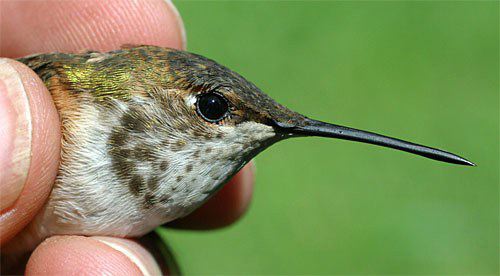 When Betty Wilson looked out her kitchen window on the evening of 29 August 2003, she felt as if she had just seen a message from beyond. Earlier that day, she completed one of the hardest tasks of her life--attending the funeral of her husband--and she was looking for a sign of better things to come. She got it in the form of a hummingbird that looked very different from those she and her husband had long enjoyed at their rural home in the Indian Land community of Lancaster County SC. Instead of seeing the expected white-bellied, green-backed Ruby-throated Hummingbirds at her feeder, she got a glimpse of an orange-tinted hummer that she immediately knew was a different species. She called a few friends to come over, and they too recognized the bird as something other than a ruby-throat. Fortuitously, when Betty opened her copy of The Herald newspaper the next morning, there was an article about a leucistic hummer we had banded earlier in the week. In a flash, Betty was on the phone to Hilton Pond Center to describe her own unusual discovery. When we arrived at the Wilson home at about 11:30 a.m. on 30 August, Betty had summoned family and friends who were both interested in the hummingbird and supportive in her time of loss. While the crowd watched, we hung our portable hummingbird trap containing one of Betty's feeders and stood back to see what would happen.
Almost immediately hummers were flying in to investigate the trap, but none entered. A few minutes later, Betty sang out "There it is!" and a different-looking hummingbird sped past. Still, nothing entered the trap until the ten-minute mark, when Betty shouted, "It's in!" Frankly, we didn't have a good enough view of the actual bird to know whether it was a ruby-throat or not, but we COULD see that it was perched on the feeder inside the trap. Trusting Betty's call, we hit the release that caused a sliding door to close, and the hummer was entrapped.
When we approached the trap we easily could see tail feathers with rusty-colored bases that would be greenish black in a ruby-throat; this characteristic alone indicated we most likely had either a Rufous Hummingbird or an Allen's. Since the latter has never been reported for South Carolina, we suspected Betty's bird was a Rufous--and a juvenile female at that--but we needed to make several measurements to confirm both suspicions. We removed the bird from the trap, gently slid it into a paper tube for safekeeping, and cleared an area on an outdoor table where Betty's neighbors could gather 'round to watch us apply band Y14845 to the bird's right leg.
Based on a combination of measurements (below), we ruled out that Betty's hummer was the somewhat smaller Allen's Hummingbird; we also confirmed that it was a female Rufous because males of that species are smaller than females. Age/Sex--Hatch year female Weight--3.8g Wing Chord--44.6mm Tail Length-26mm Tail Fork--5mm Culmen (upper bill)--18mm Bill Corrugations--Faint Gorget--no orange-red metallic feathers We determined that Betty's bird was a juvenile hatched in 2003, primarily because of the relatively rounded shape of the tail feathers and the presence of almost-microscopic bill etchings that mostly disappear in adults. Rufous Hummingbirds breed in southern Alaska, western Canada, and the northern Rocky Mountain states, and overwinter primarily in central Mexico. Historically, a few wandered eastward in winter and have been observed each year in the Atlantic and Gulf Coast states. In the past decade, however, sightings of several species of western hummingbirds have skyrocketed in the eastern U.S., and wintering Rufous Hummingbirds have become almost commonplace (see Vagrant & Winter Hummingbird Banding). It's unclear whether these sightings are the result of more people leaving feeders up in winter, if western hummers are wandering more and earlier, whether global warming is having an effect, or if there is some other combination of factors.
If you're interested in sharing your hummingbird observations and learning from other enthusiasts, you may wish to subscribe to Hummingbird Hobnob, our Yahoo!-based discussion group. Also be sure to visit our award-winning Web site for Operation RubyThroat: The Hummingbird Project; on it you'll find almost anything you want to know about hummingbirds, including more information about Hummingbird Banding.
For much more information about hummingbirds, visit Operation RubyThroat: The Hummingbird Project 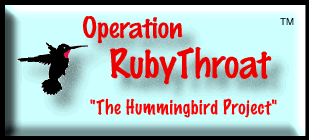 |
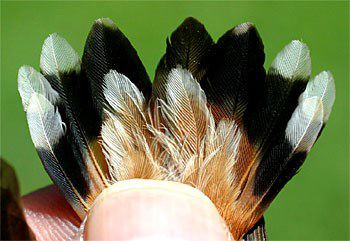 After a short conversation, we were pleased to accept an invitation to band the bird and quickly departed from York for Indian Land to see if Betty indeed had what she thought was a Rufous Hummingbird.
After a short conversation, we were pleased to accept an invitation to band the bird and quickly departed from York for Indian Land to see if Betty indeed had what she thought was a Rufous Hummingbird.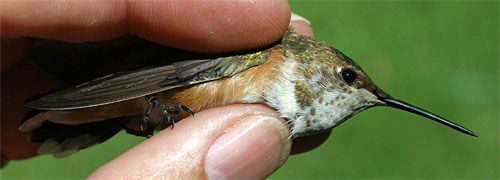
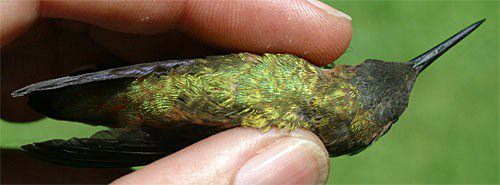

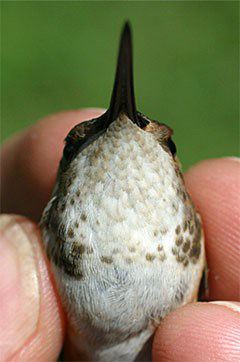 In addition, older female Rufous Hummingbirds often have one or more greenish-gold metallic feathers on the throat, but Betty's bird had the whitest gorget we've ever seen on a Rufous (below left).
In addition, older female Rufous Hummingbirds often have one or more greenish-gold metallic feathers on the throat, but Betty's bird had the whitest gorget we've ever seen on a Rufous (below left).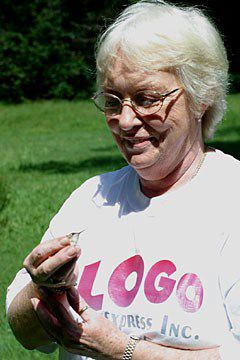 Regardless of what might have caused an "out-of-range" Rufous Hummingbird to appear suddenly in her South Carolina backyard in August, Betty Wilson (right) was ecstatic to see one at a feeder she and her husband had observed together through the years. We're likewise pleased and grateful that Betty contacted us here at Hilton Pond Center and that she was gracious enough to let us band her special bird at a difficult time. We don't know, of course, whether this particular hummer will hang around Indian Land or speed off toward points unknown, but it was still present on 31 August and wearing its new band. Regardless of its next destination, Betty Wilson's Rufous Hummingbird performed a valuable role by brightening her day when she needed it most.
Regardless of what might have caused an "out-of-range" Rufous Hummingbird to appear suddenly in her South Carolina backyard in August, Betty Wilson (right) was ecstatic to see one at a feeder she and her husband had observed together through the years. We're likewise pleased and grateful that Betty contacted us here at Hilton Pond Center and that she was gracious enough to let us band her special bird at a difficult time. We don't know, of course, whether this particular hummer will hang around Indian Land or speed off toward points unknown, but it was still present on 31 August and wearing its new band. Regardless of its next destination, Betty Wilson's Rufous Hummingbird performed a valuable role by brightening her day when she needed it most.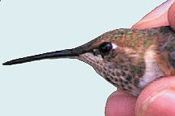
 Students at GLOBE-certified schools may submit winter hummingbird observations as part of Operation RubyThroat and GLOBE. Students can also correlate hummingbird observations with data on abiotic factors, including atmosphere, climate, hydrology, soils, land cover, and phenology. See the
Students at GLOBE-certified schools may submit winter hummingbird observations as part of Operation RubyThroat and GLOBE. Students can also correlate hummingbird observations with data on abiotic factors, including atmosphere, climate, hydrology, soils, land cover, and phenology. See the 


